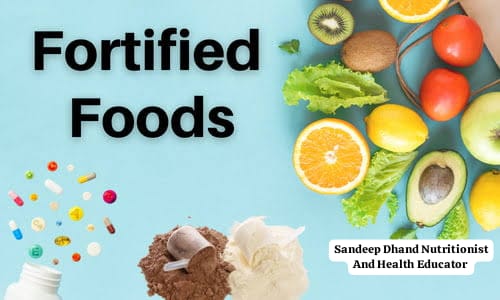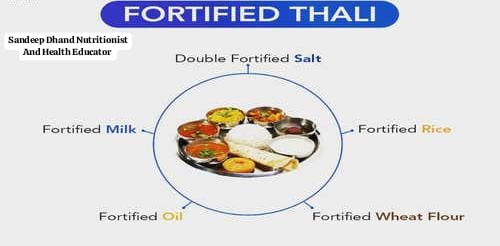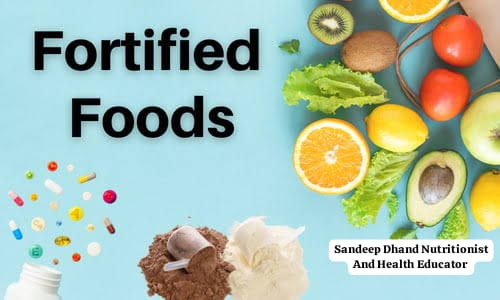Sandeep Dhand
Nutritionist And Health Educator
Fortified foods play an important role in improving nutrition and public health. These foods are enhanced with additional nutrients that may not naturally occur in them or that might have been lost during food processing. Fortification helps fill nutritional gaps in our diets and ensures people get the essential vitamins and minerals they need to stay healthy.
Let’s explore fortified foods in detail, starting with what they are, their importance, examples, benefits, challenges, and their role in public health.
What Are Fortified Foods?

Fortified foods are everyday food items that have extra nutrients added to them. These nutrients can be vitamins, minerals, or other essential substances that promote health. The purpose is to improve the nutritional value of the food and help people meet their daily nutrient requirements.
For example:
Milk fortified with Vitamin D.
Salt fortified with iodine.
Flour enriched with iron and folic acid.
Fortification is different from enrichment, which means adding back nutrients lost during food processing. For instance, when wheat is refined into white flour, nutrients like iron and B vitamins are lost. Adding these nutrients back is called enrichment. Adding new nutrients that weren’t originally there is fortification.
Why Are Foods Fortified?
Fortified foods are designed to combat nutrient deficiencies that are common in many parts of the world. Deficiencies can lead to diseases, developmental problems, and a weaker immune system. Fortification is a cost-effective and simple way to improve public health, especially for populations that might not have access to a diverse diet.

Here are some reasons why food fortification is necessary:
- Addressing Malnutrition: Millions of people suffer from “hidden hunger,” which refers to the lack of essential vitamins and minerals despite having enough to eat. Fortification helps solve this issue.
- Preventing Diseases: Deficiencies in nutrients like iodine, vitamin A, iron, and folic acid can cause serious health problems like goiter, blindness, anemia, and birth defects. Fortified foods can prevent these conditions.
- Boosting Immunity and Growth: Fortified foods provide nutrients that strengthen the immune system, improve brain development in children, and support overall health.
Types of Fortified Foods
Fortification can be applied to various types of food. Here are the most common examples:
- Salt
Fortified with iodine to prevent iodine deficiency disorders like goiter.
- Milk
Often fortified with Vitamin D to help the body absorb calcium and support bone health.
- Flour and Rice
Fortified with iron, folic acid, and B vitamins to prevent anemia and neural tube defects in babies.
- Edible Oils and Margarine
Enriched with Vitamin A and Vitamin D to combat blindness and rickets.
- Breakfast Cereals
Contain added iron, calcium, and vitamins for a nutritious start to the day.
- Juices and Drinks
Orange juice is sometimes fortified with calcium for bone health.
Examples of Nutrients Used in Fortification
- Iron
Prevents anemia by helping red blood cells carry oxygen.
- Vitamin A
Promotes good vision and boosts immunity.
- Folic Acid
Reduces the risk of birth defects in pregnant women.
- Iodine
Supports thyroid function and prevents goiter.
- Vitamin D
Strengthens bones and teeth by helping the body absorb calcium.
- Zinc
Aids in growth, wound healing, and immune function.
Benefits of Fortified Foods

- Improves Public Health: Fortified foods address nutrient deficiencies in large populations, reducing health problems caused by a lack of essential nutrients.
- Cost-Effective: Fortification is cheaper than treating diseases caused by deficiencies. It’s also more affordable than dietary supplements.
- Convenient: People don’t need to change their eating habits. Fortified nutrients are seamlessly added to everyday foods.
- Supports Vulnerable Groups: Children, pregnant women, and elderly people benefit significantly from fortified foods.
Challenges of Food Fortification
Although fortification has numerous benefits, it also faces some challenges:
- Overconsumption: Eating too many fortified foods can lead to excessive intake of certain nutrients, which may cause health problems.
For example, too much Vitamin A can be toxic.
- Cost for Manufacturers: Adding nutrients to foods increases production costs, which can be a barrier for small-scale producers.
- Not a Complete Solution: Fortified foods alone cannot replace the need for a balanced diet rich in fresh fruits, vegetables, and whole grains.
- Consumer Awareness: People may not know the importance of fortified foods and might avoid them.
How Are Foods Fortified?
Fortification involves scientific processes to add nutrients to food. These methods vary depending on the type of food being fortified:
- Blending: Mixing nutrients into the food during production. For instance, flour is fortified by blending it with iron or folic acid.
- Spraying: Spraying nutrients onto the surface of cereals or snacks.
- Encapsulation: Protecting the nutrients with a coating to prevent them from breaking down during cooking or storage.
Governments and international organizations like the World Health Organization (WHO) set guidelines to ensure fortification is safe and effective.
Fortification in Public Health Policies
Many governments worldwide have made food fortification mandatory to combat widespread nutrient deficiencies. For example:
- Iodized Salt: Globally recognized as one of the most successful fortification programs.
- Fortified Flour: Countries like India and South Africa mandate the addition of iron and folic acid to wheat flour.
- Fortified Rice: In regions where rice is a staple food, fortifying it with iron and other micronutrients has been effective.
These programs are often part of larger efforts to achieve global health goals, such as reducing malnutrition and improving maternal and child health.
Conclusion
Fortified foods are a powerful tool to fight malnutrition and nutrient deficiencies. They are practical, cost-effective, and widely accessible, making them an important part of public health strategies.
However, it’s essential to remember that fortified foods are not a substitute for a balanced diet. They work best when combined with fresh, natural foods that provide a wide range of nutrients. Awareness, government support, and consumer education are key to making fortification programs successful.
By including fortified foods in your diet, you can improve your health and contribute to a world where fewer people suffer from the consequences of nutrient deficiencies.